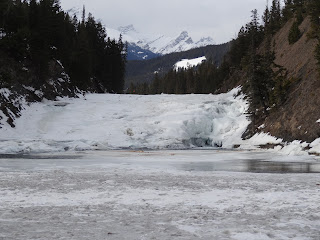I had a day off and the opportunity to do some sight seeing.
I decided to head to Baanf in the Rocky Mountains.
Baanf is a Ski resort area and in the holiday season is flooded with tourists.
It is about an hour and a half east of Calgary.
Lake Louise is another hour and a half drive
from Baanf and I was told is well worth the drive if time allows. Unfortunately
as with most parts of my traveling I had to see it at Lightening pace, and so
will have to add it to my bucket list. I
took the sky lift to the top of Sulphur
Mountain to a weather
observatory, which hade been used to make recordings from 1903 to 1931.
(This would have been quite an effort before the Sky lift). The Summit rising 600m above
Baanf provided fantastic views of the surrounding snow capped mountains.

After heading back down the sky lift I visited the Baanf hot springs, which are
said to have therapeutic properties. Sitting in the 39 deg C outside swimming
pool, the snow capped mountains and
countryside provided an amazing, almost surreal backdrop.
My next stop was the waterfall and lake. It really helps you
understand just how cold it is when you can look at a waterfall that is almost
completely frozen over.
From the lake I headed to the Baanf resort. When the
East/West railway was originally constructed, there was a big question over how
it could remain profitable and be paid for. Baanf as a tourist destination was
the answer. The lure of the therapeutic springs and the beautiful countryside
brought tourists by the thousands along the railway to the resort, securing the
profitability of the venture.
I finished my visit to Baanf at a couple of lookouts where
you could see the amazing folding and fracturing of rock that had occurred to
form the mountain range. You cannot help but stand in awe at the forces
required to push the ocean floor to these heights.














.JPG)
.JPG)
.JPG)
.JPG)
.JPG)
.JPG)
.JPG)








.JPG)





.JPG)













